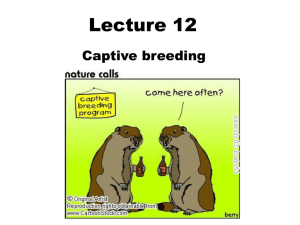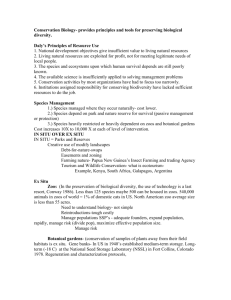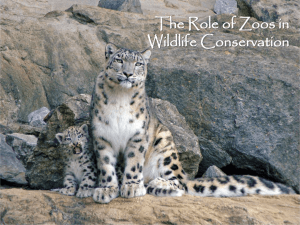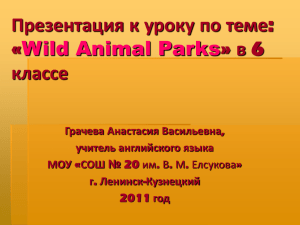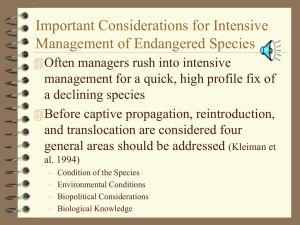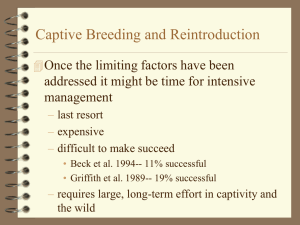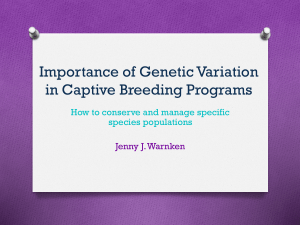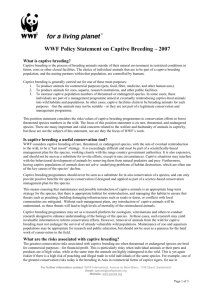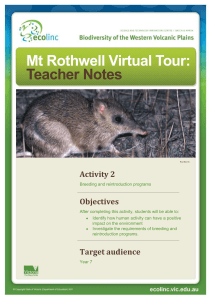ex situ conservation - Plant Ecology at Syracuse
advertisement
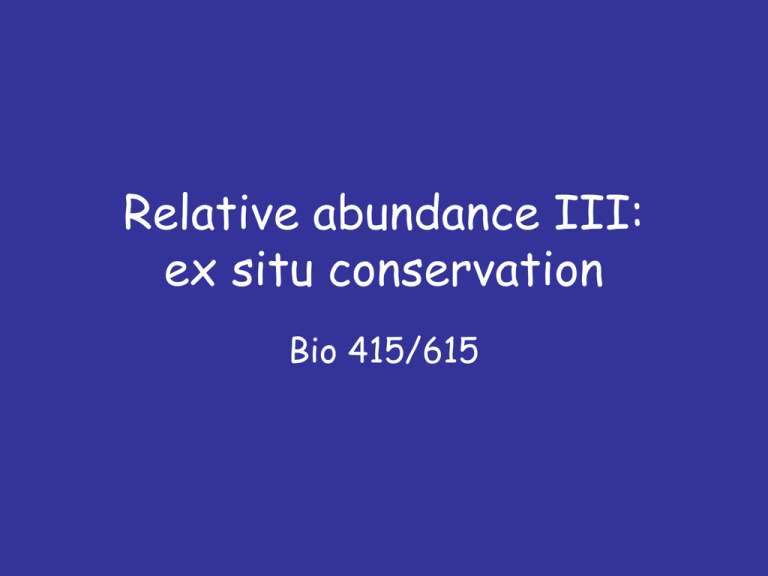
Relative abundance III: ex situ conservation Bio 415/615 Questions 1. How do zoos and botanical gardens contribute to natural biodiversity? 2. What are three dangers of ex situ conservation? 3. What is the purpose of a germplasm repository? 4. What are two necessary considerations when reintroducing captive species back to nature? Ex situ conservation Leopold’s First Law of Tinkering “To save every cog and wheel is the first precaution of intelligent tinkering.” Zoos and conservation Cincinnati Zoo The last WILD passenger pigeon Smithsonian Carolina parakeet Conuropsis carolinensis Passenger Pigeon Extopistes migratorius Zoos contributions to biodiversity • Zoo populations are now the only representatives of several species, including until very recently the California condor (Cymnogyps californianus) and the black-footed ferret (Mustela nigripes), and at least 18 species have been reintroduced into the wild after captive propagation. Zoos contributions to biodiversity • In at least six cases--Pere David deer (Elaphurus davidianus), Przewalski horse (Equus przewalski), red wolf (Canis rufus), Arabian oryx (Oryx leucorx), American Bison (Bison bison), Guam kingfisher (Halcyon cinnamomina cinnamomina), and Guam rail (Rallus owstoni)--the species were extinct in the wild at the time of reintroduction-extinct for some 800 years in the case of the Pere David deer! (A) Père David’s deer has been extinct in the wild since ~1200 (B) Przewalski’s horse American Bison Mound of bison skulls, mid-1870s • Once widespread in both prairie and woodlands • Hunted to just a few hundred animals in 1880s; also identity lost via cattle hybrids • Handful of private ranchers bred them back from extinction • Today ca. 350,000; but 2/3 are raised as livestock; very few ‘pure’ bison pop’s Captive Breeding • Captive breeding programs may be some species’ only hope for survival. • To strengthen and coordinate captive programs in North America, the Species Survival Plan (SSP) was developed by the American Zoo and Aquarium Association (AZA) in 1981. Saved by Zoos?: Recent Extinctions in Wild • Golden Frog (Atelopus zeteki) • Native to Panama, extinct in wild in 2007 • Survivors of last known population captured for captive breeding Saved by Zoos?: Recent Extinctions in Wild • Spix's Macaw (Cyanopsitta spixii) • Native to central Brazil, presumed extinct in wild in 2000 Species Survival Plan • Cooperative that manages captive breeding of ca. 160 species nationwide • Many are ‘flagship’ species • Eg: giant panda, CA condor, gorilla • Some SSP projects include reintroduction (CA condor, red wolf, black-footed ferret) Giant Panda Not released into the wild – don’t know how to survive Increased attention for limited persisting range California Condor Once spread across most of western and southern U.S. Eventually all surviving wild individuals caught and reared in captivity – as a strategy for species survival From 22 to 289 individuals – now breeding in wild again Imprinting on a puppet Zoos contributions to biodiversity Zoos contributions to biodiversity • Indirectly contribute to In situ conservation through public education and awareness • Increases interest in saving species endangered with extinction • “Animal Ambassadors” • Zoos directly contribute yearly to research and conservation of wild populations Some dangers of ex situ conservaton • ????? Some dangers of ex situ conservaton • Genetic drift in small populations (Ne) • New selective environment – Conscious, unconscious • Hybridization • Can appear to replace need for in situ conservation • Turnover in zoo populations can create a net drain on wild populations (80:1 in abnormalities; 75% to 3% of skeletons; Feduccia 1991) Link to reintroduction & restoration is essential Botanical gardens, too Global Totals: 4 million individual plants 80,000 species ~30% of the world’s total Franklinia -- Franklinia alatamaha 1765 Wm & John Bartram, Altamaha River, Georgia (map misspelling!) 1803 Last seen in wild The National Center for Genetic Resources Preservation (NSSL) (USDA), Ft. Collins, CO The National Center for Genetic Resources Preservation (NSSL) (USDA), Ft. Collins, CO • More than just plants • Major cryobiological facilities – Seed bank – Living tissue (bud grafts) – Animal genetic resources (such as semen) National Seed Storage Laboratory (USDA), Ft. Collins, CO -18 C -196 C Liquid N National Seed Storage Laboratory (USDA), Ft. Collins • About 475,000 ‘accessions’ (bag of seed, plant tissue culture, etc) • Each accession is 3,000-5,000 seeds • Includes about 10,000 species • Storage methodology is crucial Seed Dormancy Drying, Cooling, Aging Orthodox Seeds: dessication tolerant, longlived [vary in reaction to RATE of drying and FINAL MOISTURE content] Intermediate: partially dessication tolerant, short-lived Recalcitrant Seeds: dessication sensitive Preserving rare/traditional breeds of domesticated plants and animals: Issue of efficiency in production vs. variety Threatened loss of genetic diversity and traits important to disease resilience and resistance Why did the Irish immigrate in such high numbers to the U.S. in the mid 1800s? Why did the Irish immigrate in such high numbers to the U.S. in the mid 1800s? Potato Blight (Phytophthora infestans ) 500,000 to 1.5 million people died of hunger Millions more emigrated Crop species show high genetic diversity in certain areas of the world Real goal: Reintroduction 3 types of release programs: 1. Reintroduction (gone, return) 2. Augmentation (still there, more added) 3. Introduction (never there, added) A. For conservation purposes (rare species) i.e. Translocations B. For other purposes (exotic species) i.e. exotic introduction Reintroduction issues • Historic precedence & scale: how to decide where and how many? • Source populations: where from? • Genetic diversity: to mix or not? • Microhabitat match • Habitat protection, quality, population growth rate • Pest, disease transmission Reintroduction isn’t easy: Griffith et al. 1989 – probability of success in: excellent quality habitat 84% poor quality habitat 38% core of historic range 78% periphery of the historic range 48% wild-caught animals 75% captive-reared animals 38% herbivores 77% carnivores 48% Grey Wolf Recovery The Mexican Grey Wolf – Canis lupus baileyi The Mexican Grey Wolf – Canis lupus baileyi • Only a few hundred Mexican wolves alive • Historically in northern Mexico and southwestern U.S. • Hunted to near extinction by Ranchers • Captive-reared wolves have been released into wilderness area of NM and AZ • Of the 34 wolves initially released (in the late 90’s): five were shot; one disappeared; one was hit by a vehicle; five were returned to captivity; and 22 became free-ranging. REWARDS OFFERED The U.S. Fish and Wildlife Service is offering a reward of up to $10,000 for information leading to the conviction of the individual or individuals responsible for the shooting deaths of Mexican gray wolves. An additional $10,000 is being offered by Defenders of Wildlife, and $5,000 is being offered by the Center for Biological Diversity. Individuals with information they believe may be helpful are urged to call one of the following agencies: U.S. Fish and Wildlife Service special agents in Mesa, AZ, at (480) 967-7900, Pinetop, AZ, at (928) 367-5689, or Albuquerque, NM, at (505) 346-7828; the White Mountain Apache Tribe at (928) 338-1023 or (928) 338-4385; Arizona Game and Fish Department Operation Game Thief at 1-800-352-0700; or New Mexico Department of Game and Fish Operation Game Thief at 1-800-432-4263. Killing a Mexican gray wolf is a violation of the federal Endangered Species Act, and can invoke criminal penalties of up to $25,000 and/or six (6) months in jail or a civil penalty of up to $25,000. http://www.blackfootedferret.org/ http://www.youtube.com/watch?feature =player_embedded&v=O0hlja5krQQ#! "The precise total number of breeding adult blackfooted ferrets extant in the wild is unknown because of monitoring limitations. However, in the fall of 2008 a minimum of 700 ferrets occured in the four "successful" reintroduction sites (Aubrey Valley, Arizona; Cheyenne River Sioux Reservation, South Dakota; Conata Basin, South Dakota; and Shirley Basin, Wyoming). Assuming that approximately 50 percent of ferrets counted in fall surveys survive to become breeding adults the following spring, there are approximately 350 breeding adults at these four successful sites. Accordingly, it appears that as of 2011, downlisting efforts may be 40 percent complete with regard to establishing 10 successful populations and approximately 23 percent complete with regard to the goal of 1,500 breeding adults. An additional number of at least 1,150 breeding adults are needed at existing or new sites to meet the downlisting goals. It has taken 20 years of reintroduction efforts to reach this point in ferret recovery. Accordingly, we are modifying the year of achieving downlisting goals estimated in the 1988 Recovery Plan from 2010 to 2020. Additionally, we estimate meeting delisting goals by 2040. These estimates assume progress similar to what has been achieved in recent years." The circles represent individuals of different age classes. Age-structured matrix model The P values are survival from one year to the next. The F values are per capita offspring production. The italicized numbers represent the importance of different age-based processes. What is the most important component of the population to manage from a conservation standpoint?
